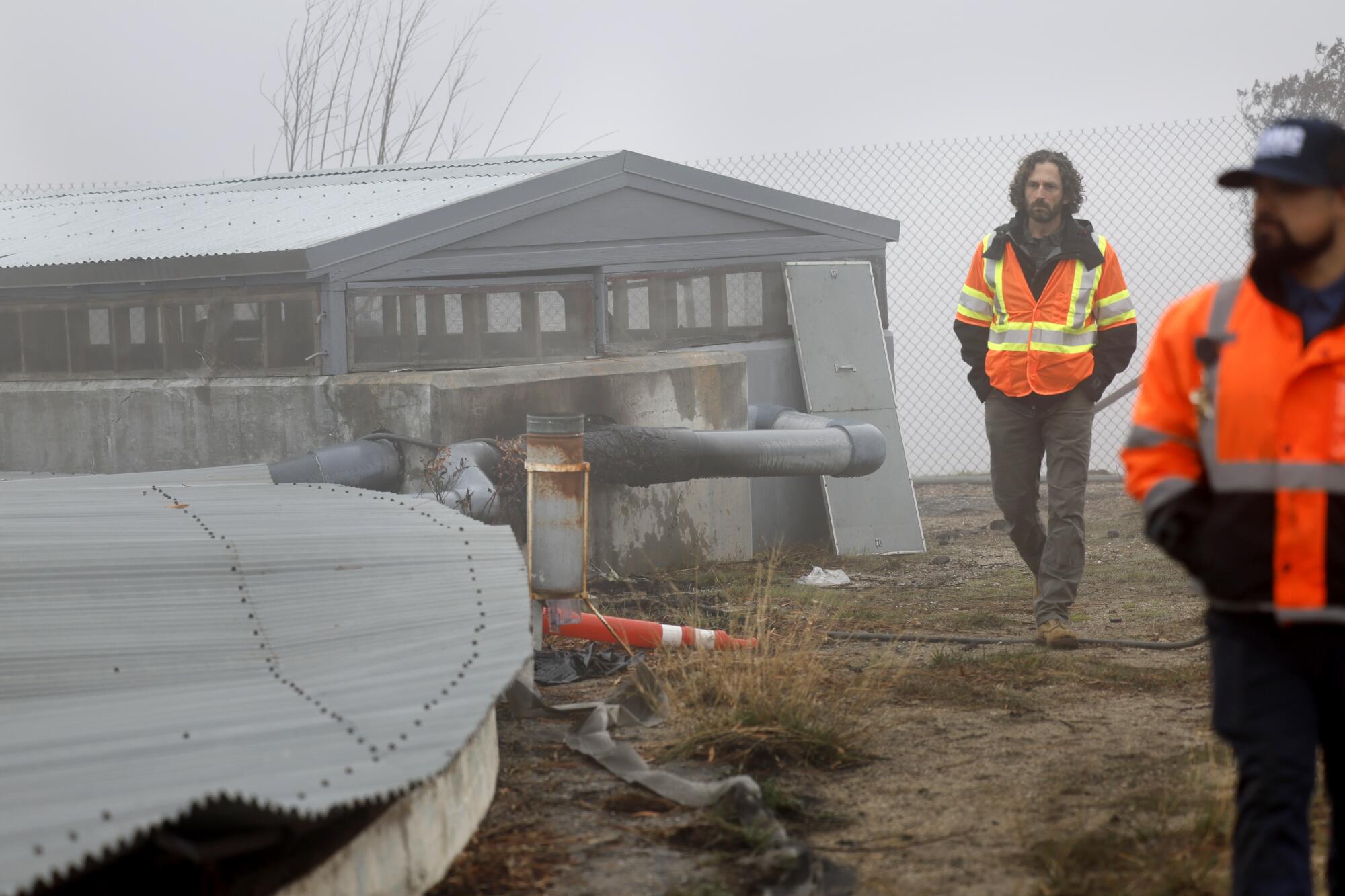
- Share via
Scientists have released some of the first independent test results confirming that drinking water in fire-affected areas around Altadena and Pacific Palisades is largely free of harmful contaminants, as an Altadena utility lifted the last “do not drink” notice left in the burn zones.
Researchers with the LA Fire HEALTH Study released results on Friday from 53 homes spread across the burn areas and the more than three miles surrounding them. They found only one with a toxic substance at dangerous levels: at one home, the water contained benzene, a known carcinogen, at concentrations slightly above the state’s allowable level of 1 part per billion.
The findings add to mounting evidence that the affected area’s drinking water is safe. In March, Caltech professor Francois Tissot’s team found no lead levels above the U.S. Environmental Protection Agency’s limit in the tap water of the 43 homes tested in Altadena and surrounding communities. Separately, UCLA professor Sanjay Mohanty’s group found no concerning levels of heavy metals or potentially harmful “forever” chemicals in 45 homes tested in the Palisades.
Experts noted that LA Fire HEALTH Study’s elevated benzene level finding — at 1.6 ppb — remains below the federal limit of 5 ppb and would probably drop below 1 ppb once the homeowner follows the utilities’ recommendation to run all faucets in the entire house for at least five minutes to flush contaminants out of the lines before using the tap water.
The state’s limit of 1 ppb equates to no more than a two-in-one-million chance of a resident developing cancer from a lifetime exposure to the contaminant at that level, according to the State Water Resources Control Board. For higher, short-term exposures to benzene, the U.S. EPA says exposure to more than 200 ppb for more than a day could have negative, non-cancer health consequences for children.
“I’m optimistic from these results,” said Chris Olivares, a professor of civil and environmental engineering at UC Irvine who has led the tap water testing part of the LA Fire HEALTH Study. “The major takeaway, I think, is the importance of flushing.”
The federal government decided not to test the soil of L.A.’s burn areas for hazardous substances. A Times investigation found high levels of lead and other heavy metals.
Andrew Whelton — a professor of civil and environmental engineering at Purdue University and a pioneer in the field of post-fire water contamination and remediation — attributes the quick and successful restoration of safe drinking water to the hard work of local utilities and state regulators, which followed a post-fire playbook Whelton and others developed in the wake of the 2017 Tubbs fire in Santa Rosa, the 2018 Camp fire in Paradise and subsequent fires throughout Colorado in 2021 and Hawaii in 2023.
The way dangerous volatile organic compounds, such as benzene, could contaminate water supplies after a wildfire wasn’t well known or studied until a Santa Rosa resident reported a strong smell of gasoline — a signature indicator of benzene — when turning on their kitchen faucet for the first time after the 2017 fire.
Scientists and public health officials raced to understand and solve the problem. They found benzene levels as high as 40,000 ppb, and it took a year to restore safe water.
After the Camp fire, scientists found levels over 900 ppb, which took eight months to remediate.
After the L.A. County fires, the Los Angeles Department of Water and Power found one instance of benzene at 71.3 ppb. The utility worked around the clock to restore safe water, first by closing roughly 4,800 open connections at fire hydrants and destroyed homes to restore water pressure, then continuously flushing water out of the system to push out contaminants. As they went, they tested and retested until benzene levels dropped to near zero.
LADWP — with the approval of the State Water Resources Control Board — lifted its “do not drink” notice on March 7, exactly two months after the Palisades fire broke out. Two of the three smaller customer-owned utilities in Altadena, Lincoln Avenue Water Co. and Rubio Cañon Land and Water Assn. — which also detected benzene in their systems after the fires — quickly followed. The third, Las Flores Water Co., lifted the last “do not drink” notice on May 9.
Las Flores had registered the highest benzene levels of all the utilities: 440 ppb from a sample collected on April 10.
The LA Fire HEALTH Study team tested roughly eight homes within each burn area and over a dozen in adjacent communities between February and April while the testing and flushing process was ongoing.
The results are some of the first from the LA Fire HEALTH Study’s broad-ranging, privately funded effort between nearly a dozen academic and medical institutions, to understand the health consequences of the L.A. County fires over the course of 10 years.
Outside the burn areas, no homes the team sampled exceeded the state’s allowable limit for benzene or any of the other two dozen volatile organic compounds for which the group tested. And inside the burn areas, benzene was the only contaminant that exceeded the state’s allowable limits.
Water utilities in Altadena and Pacific Palisades are undertaking an arduous process of repressurizing their underground pipelines, testing for contaminants and attempting to flush them out.
Although the utilities have worked for months to flush contaminants out of the labyrinth of pipes carrying water from reservoirs to private properties, it’s homeowners who are responsible for finishing the job and flushing the pipes on their own properties.
The researchers stressed that the one benzene exceedance — found in Lincoln Avenue’s service area one week after the utility’s “do not drink” notice was lifted — is a reminder that residents should follow the utilities’ guidance for safe water use once returning home.
“Lincoln Avenue Water Company’s top priority is to provide safe and reliable drinking water to the community. Through extensive testing, we have established that our system is in compliance with all state and federal water quality standards,” said Lincoln Avenue general manager Jennifer Betancourt Torres, in a statement to The Times.
“It’s important to emphasize that samples taken from inside the home are considered a representation of the residential plumbing and not the water being delivered,” she said.
The utilities and water safety experts say residents should first flush all of their lines — every faucet and spigot, both hot and cold, for at least five minutes. They should also run all appliances and fixtures, such as dishwashers and washing machines, once with hot water before using. Two batches of ice from a fridge icemaker should be discarded.
The utilities are providing detailed, up-to-date guidance for their customers on their respective websites, including LADWP, Rubio Cañon, Lincoln Avenue and Las Flores.
Times staff writer Ian James contributed to this report.









